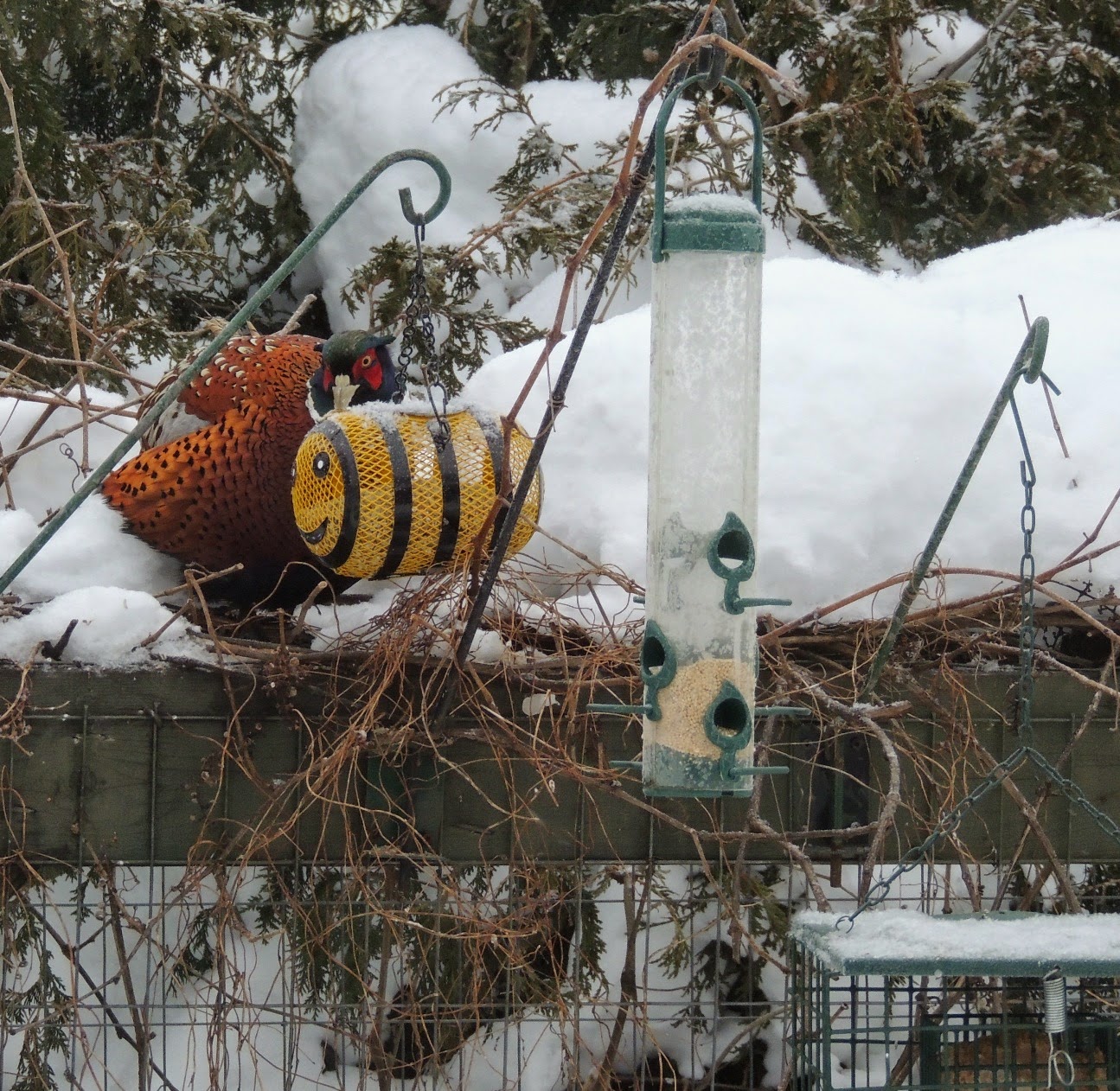**Kathleen Spicer got a photo of a dark-plumaged RING-NECKED PHEASANT
[Faisan de Colchide] in the Sackville area recently. It's a very
different plumage. It would appear to be a female. Any further
comments, please?
**Lisa Morris noted some very fresh workings of a PILEATED WOODPECKER
[Grand Pic] in Centennial Park on Friday, with the huge splinters on
the ground below. All three of Moncton's woodland parks host this top
member of the royal court of Woodpeckers [Pic].
**Anne Marsch had a nice Grosbeak [Gros-bec] visit on Friday morning
when 25 EVENING GROSBEAKS [Gros-bec errant] arrived to her Lower
Coverdale yard, enjoying a cracked corn breakfast that had been set
out
for Ducks [Canard] and Pheasants [Faisan]. Anne comments the CARDINAL
[Cardinal rouge] goes to the cracked corn as well.
**It never fails to amaze what bird species end up at peanut butter.
On Friday morning our resident RING-NECKED PHEASANT [Faisan de
Colchide] decided to go to the top of the bird feeding enclosure to
chow down on peanut butter, then cross over to a sunflower chip
feeder
to finish off.
**Brian Stone and I went back to further study a large group of Gulls
[Goéland] that were in a feeding frenzy at a farm in Maccan on
Sunday.
When we returned on Thursday the farmer was busy moving the object of
their interest inside, which turned out to be truckloads of french
fries and brewers' grain he takes from respective manufacturing
plants
as cattle feed. With the french fry component, little wonder the
large
flock was predominantly ICELAND GULLS [Goéland arctique]. It was a
great chance to get close-up observations of Gulls [Goéland] in their
differing phases, but they chose to stay in the air, and to wait in a
nearby field on Thursday.
This Week’s Sky at a Glance, February 13 – 21
On Wednesday,
February 18, the Moon will go into its New Phase meaning we will not see it
during the night. Expect higher high tides and lower low tides
On Thursday the 19th, you can catch the hairline
crescent Moon far to the lower right of Venus and Mars. It's only one day old!
Bring binoculars.
Venus, Mars, and the Moon form a tight bunch as
twilight fades. Mark your calendar for this one!
A day later Mars and Venus appear closest, with the
thickening crescent now above them.
After dusk at this time of year: Ursa Major is in
the northeast with the Big Dipper as its brightest part.
Bright
Capella passes straight overhead, or nearly so, around 8 p.m. And whenever
Capella passes highest, Rigel in Orion's foot is always due south.
Mid-February is when Orion stands highest in the
south at dusk. His eastern shoulder, orange-red Betelgeuse, forms the Winter
Triangle with brilliant Sirius far below and Procyon to their left.
Mars is now just 2° above Venus in the
west-southwest at dusk. They'll remain at least this close for the next nine
days.
On
Friday, February 20, Venus, the thin crescent Moon, and little Mars form a
tight bunch in the west-southwest during and after dusk. They
fit in a circle just 2° across at the times of dusk. for most of North America.
On Saturday, February 21, Venus and Mars are in
conjunction 0.4° apart at dusk, with the Moon now looking on from on high.
On Saturday,
February 14, the sun rose at 7:25 a.m. and will set at 5:42 p.m. giving 10
hours 17 minutes of daylight. On
Saturday, February 21, the sun will rise at 7:13 a.m. and set at 5:52 p.m. to
give 10 hours 39 minutes of daylight hours (These values are for Moncton, New
Brunswick).
The days are getting longer!
This Week's Planet Roundup
Mercury (about magnitude +0.2) is becoming visible before sunrise. Look for it
just above the east-southeast horizon in early dawn. As the sky brightens,
you'll need binoculars.
Venus (magnitude
–3.9) and Mars (less than 1% as bright, at magnitude +1.2) are drawing
close together in the west-southwest during evening twilight. The gap between
them diminishes this week from 4° on the 13th (when Mars is on top) to 0.4° at
their conjunction on the evening of Saturday the 21st (with Mars just to
Venus's upper right). On Friday the 20th, the crescent Moon joins them to make
a beautiful bunch.
Jupiter (magnitude –2.6) was at opposition last week. Watch for it coming into
view in the east as twilight fades. By 8 p.m. Jupiter is high in the east. By 11
p.m. it's essentially as high as it will get.
Saturn (magnitude
+0.5) rises around 2 a.m. It’s placed fairly high in the south as dawn begins.
Below Saturn by 9° is orange Antares.
Nelson Poirier
Nature Moncton
EVENING GROSBEAKS FEB. 13-15 ANNE MARSCH (2)
GULL FLOCK. FEB. 12, 2015. BRIAN STONE
PILEATED WOODPECKER WORKINGS AT CENTENNIAL PARK.FEB 13, 2015.LISA MORRIS
RING-NECKED PHEASANT (DARK PLUMAGE) FEB 13, 2015.KATHLEEN SPICER.
RING-NECKED PHEASANT TO PEANUT BUTTER.FEB 13, 2015.NELSON POIRIER
RING-NECKED PHEASANT TO SUNFLOWER CHIPS.FEB 13, 2015.NELSON POIRIER
.jpg)


%2BFEB%2B13%2C%2B2015.KATHLEEN%2BSPICER..jpg)

